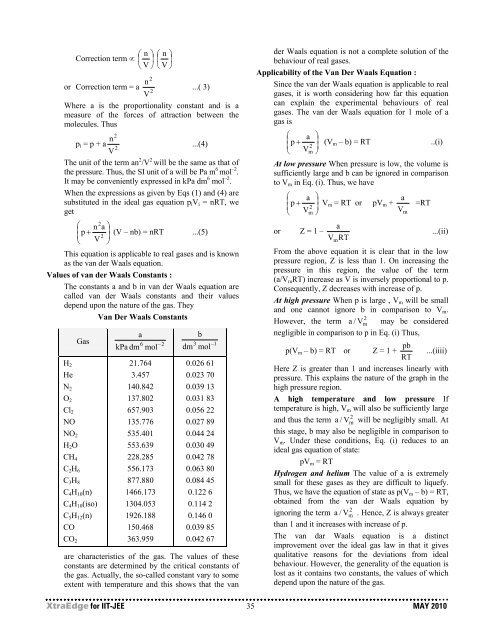Create successful ePaper yourself
Turn your PDF publications into a flip-book with our unique Google optimized e-Paper software.
⎛ n ⎞ ⎛ n ⎞<br />
Correction term ∝ ⎜ ⎟ ⎜ ⎟<br />
⎝ V ⎠ ⎝ V ⎠<br />
2<br />
n<br />
or Correction term = a<br />
...( 3)<br />
2<br />
V<br />
Where a is the proportionality constant and is a<br />
measure of the forces of attraction between the<br />
molecules. Thus<br />
2<br />
n<br />
p i = p + a<br />
...(4)<br />
2<br />
V<br />
The unit of the term an 2 /V 2 will be the same as that of<br />
the pressure. Thus, the SI unit of a will be Pa m 6 mol –2 .<br />
It may be conveniently expressed in kPa dm 6 mol –2 .<br />
When the expressions as given by Eqs (1) and (4) are<br />
substituted in the ideal gas equation p i V i = nRT, we<br />
get<br />
⎛<br />
2<br />
⎞<br />
⎜<br />
n a<br />
p + ⎟ (V – nb) = nRT ...(5)<br />
2<br />
⎝ V ⎠<br />
This equation is applicable to real gases and is known<br />
as the van der Waals equation.<br />
Values of van der Waals Constants :<br />
The constants a and b in van der Waals equation are<br />
called van der Waals constants and their values<br />
depend upon the nature of the gas. They<br />
Van Der Waals Constants<br />
a<br />
Gas 6 2<br />
kPa dm mol –<br />
H 2<br />
He<br />
N 2<br />
O 2<br />
Cl 2<br />
NO<br />
NO 2<br />
H 2 O<br />
CH 4<br />
C 2 H 6<br />
C 3 H 8<br />
C 4 H 10 (n)<br />
C 4 H 10 (iso)<br />
C 5 H 12 (n)<br />
CO<br />
CO 2<br />
21.764<br />
3.457<br />
140.842<br />
137.802<br />
657.903<br />
135.776<br />
535.401<br />
553.639<br />
228.285<br />
556.173<br />
877.880<br />
1466.173<br />
1304.053<br />
1926.188<br />
150.468<br />
363.959<br />
b<br />
dm<br />
3 mol –1<br />
0.026 61<br />
0.023 70<br />
0.039 13<br />
0.031 83<br />
0.056 22<br />
0.027 89<br />
0.044 24<br />
0.030 49<br />
0.042 78<br />
0.063 80<br />
0.084 45<br />
0.122 6<br />
0.114 2<br />
0.146 0<br />
0.039 85<br />
0.042 67<br />
are characteristics of the gas. The values of these<br />
constants are determined by the critical constants of<br />
the gas. Actually, the so-called constant vary to some<br />
extent with temperature and this shows that the van<br />
der Waals equation is not a complete solution of the<br />
behaviour of real gases.<br />
Applicability of the Van Der Waals Equation :<br />
Since the van der Waals equation is applicable to real<br />
gases, it is worth considering how far this equation<br />
can explain the experimental behaviours of real<br />
gases. The van der Waals equation for 1 mole of a<br />
gas is<br />
⎛ ⎞<br />
⎜<br />
a<br />
p + ⎟ (V 2<br />
m – b) = RT ..(i)<br />
⎝ V m ⎠<br />
At low pressure When pressure is low, the volume is<br />
sufficiently large and b can be ignored in comparison<br />
to V m in Eq. (i). Thus, we have<br />
⎛ ⎞<br />
⎜<br />
a<br />
⎟<br />
a<br />
p + V 2<br />
m = RT or pV m + =RT<br />
⎝ V m ⎠<br />
V m<br />
a<br />
or Z = 1 –<br />
...(ii)<br />
VmRT<br />
From the above equation it is clear that in the low<br />
pressure region, Z is less than 1. On increasing the<br />
pressure in this region, the value of the term<br />
(a/V m RT) increase as V is inversely proportional to p.<br />
Consequently, Z decreases with increase of p.<br />
At high pressure When p is large , V m will be small<br />
and one cannot ignore b in comparison to V m .<br />
2<br />
However, the term a / V m may be considered<br />
negligible in comparison to p in Eq. (i) Thus,<br />
pb<br />
p(V m – b) = RT or Z = 1 + ...(iiii)<br />
RT<br />
Here Z is greater than 1 and increases linearly with<br />
pressure. This explains the nature of the graph in the<br />
high pressure region.<br />
A high temperature and low pressure If<br />
temperature is high, V m will also be sufficiently large<br />
2<br />
and thus the term a / V m will be negligibly small. At<br />
this stage, b may also be negligible in comparison to<br />
V m . Under these conditions, Eq. (i) reduces to an<br />
ideal gas equation of state:<br />
pV m = RT<br />
Hydrogen and helium The value of a is extremely<br />
small for these gases as they are difficult to liquefy.<br />
Thus, we have the equation of state as p(V m – b) = RT,<br />
obtained from the van der Waals equation by<br />
2<br />
ignoring the term a / V m . Hence, Z is always greater<br />
than 1 and it increases with increase of p.<br />
The van dar Waals equation is a distinct<br />
improvement over the ideal gas law in that it gives<br />
qualitative reasons for the deviations from ideal<br />
behaviour. However, the generality of the equation is<br />
lost as it contains two constants, the values of which<br />
depend upon the nature of the gas.<br />
XtraEdge for <strong>IIT</strong>-<strong>JEE</strong> 35 MAY 2010

















